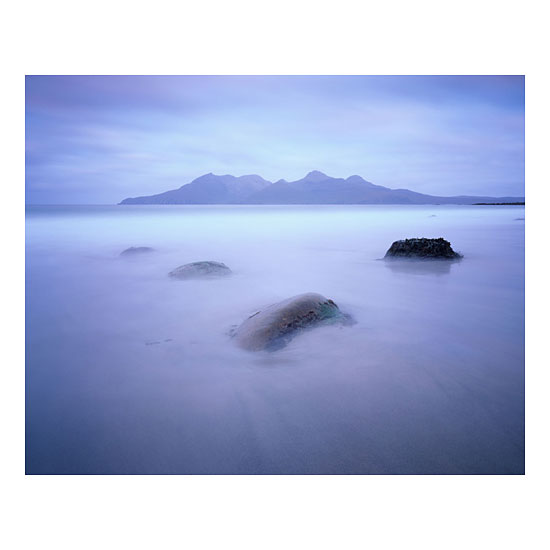I’m sure all of us have had a positive encounter with someone, at some crucial moment, which has changed the course of our lives in some way.
Well, similar to this, I believe that some landscapes, when I've met them at a certain point in my own creative life, have changed the course of my own photographic development.
Seilebost beach, Isle of Harris, Scotland. Image © Bruce Percy 2014.
Seilebost becomes a massive sand flat at low tide. It's this vastness and space that allowed me to see parallels with the empty landscapes of the Bolivian Altiplano - a landscape that has taught me so much.
I remember many years ago first visiting the Isle of Harris in the far north west of Scotland. I was struck by the beauty of the beaches there, but I had difficulty in translating the scenery into photographs that conveyed what I was feeling. I've had many encounters such as this in my photographic life where I've visited a place, and although I love it and find it extremely beautiful, I'm still at a loss as to how to photograph it (well). Making good photographs is not simply a case of finding good compositions and good light, but it's more than this for me: it's about finding an underlying theme - something which gives the body of work a sense of cohesion.
I tend to look at these encounters with the view that perhaps I'm not approaching the place the right way, or that perhaps I'm simply not ready as a photographer to get out of the experience what I feel is there. That doesn't mean I shouldn't try - it just means that perhaps I haven't the skills yet to convey what I'm seeing.
Take this case in point. It had been four years since I had last visited Harris. In the intervening years, I had photographed many ‘empty places’ that had taught me so much. I felt that if I returned to Harris now, I might have a better handle on how to approach its minimalistic landscape.
It was just a hunch, but I feel I've worked on my self-awareness enough to understand that what I am looking for has changed over the years. When I first started out making pictures, I was always looking for the iconic - for places that were easily recognisable, and also objects that are easily understood (trees, rivers, mountains). See 'association versus the anonymous' for more on this. More recently I've found I'm much more interested in the mood and atmosphere of a place rather than photographing known or easy to understand objects asI believe photographs can be extremely powerful if tones and colours are used to spark an emotional response. Well, that's how I see it anyway.
Laguna Colorada, Bolivian Altiplano. Image © Bruce Percy 2013
Laguna Colorada is a red lake at high altitude. There are no structures such as mountains or trees in this landscape to grab onto for security. You have no alternative, but to work with what it gives you - tones and colours only.
I show both these photos for one purpose: to illustrate that the Bolivian shot made in 2013 helped me 'see' how I could approach the Isle of Harris here in Scotland. Ok, you might want to discuss how both images are quite similar, and maybe you’re thinking I've just borrowed from a template of what worked previously. But I feel the similarity is due to much more than that.
Firstly, when I went to Bolivia, I was forced to work with tones and colours because sometimes there's not a whole lot else in the landscape to work with.
(On a side note I fully appreciate that it can be quite daunting for many of us and I would not criticise anyone for feeling there was 'nothing there to photograph'. I feel so often I rely on easy to understand objects such as trees, rocks and mountains to give my photographs focus. But i've realised that the act of looking for recognisable objects in the landscape is sometimes just me looking for a emotional crutch, and what I'm really doing, is avoiding working with what i’ve been given).
Since visiting Bolivia and learning to work with empty places, the experience has had far reaching repercussions for my photography. I now find it much easier to approach empty places with confidence and to work with different climatic conditions. I often see parallels between one landscape and another and I utilise these relationships when I'm aware of them. For example, the black beaches of Iceland have taught me how to approach the black volcanic lagoons of Patagonia. I see parallels all the time now and I know this is because one landscape teaches me how to photograph another.
As for the Isle of Harris: I remember when I made the image you see at the top of this post. I was on the beach with my group of workshop participants, and one of them, Carlos said to me 'this reminds me of your Bolivian Altiplano shots', to which I replied 'Yes!'. Most of the time however, the connection isn't so obvious. It can often be an unconscious process where I realise many months or years later that there is a connection between one place and another. That's why it's taken me about six years to figure out how I think Harris is best conveyed. I needed to go to Bolivia first to be taught how to work with empty places before I could approach a part of my own country.
Some landscapes have the power to shape us. They can be road-signs to show us where we are going with our photography. It's just up to us to have the awareness skills to see the connection, or let the connection come to us many years down the line, and run with it.
















